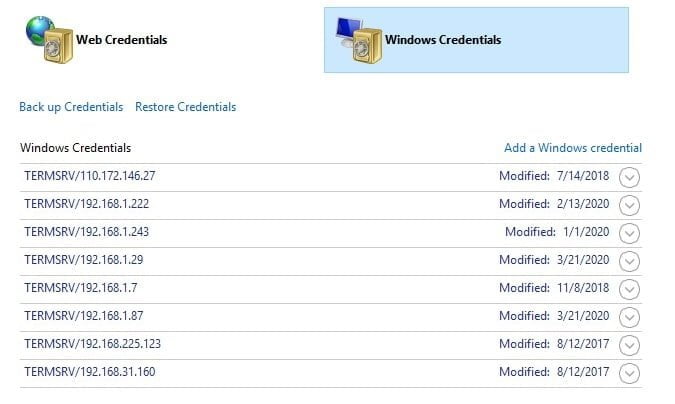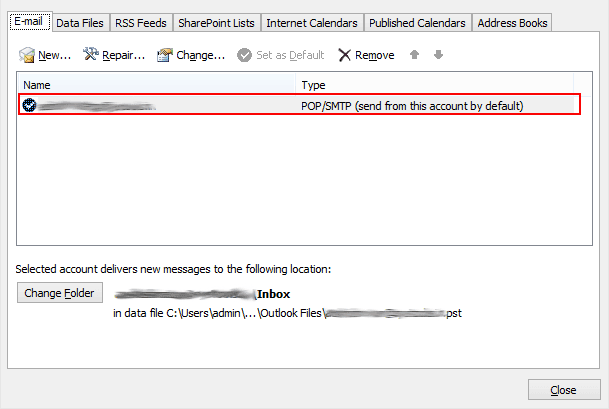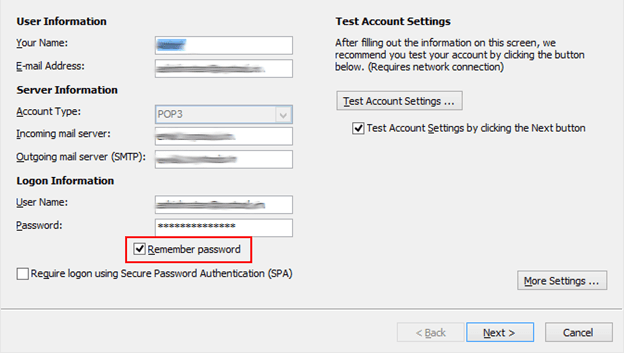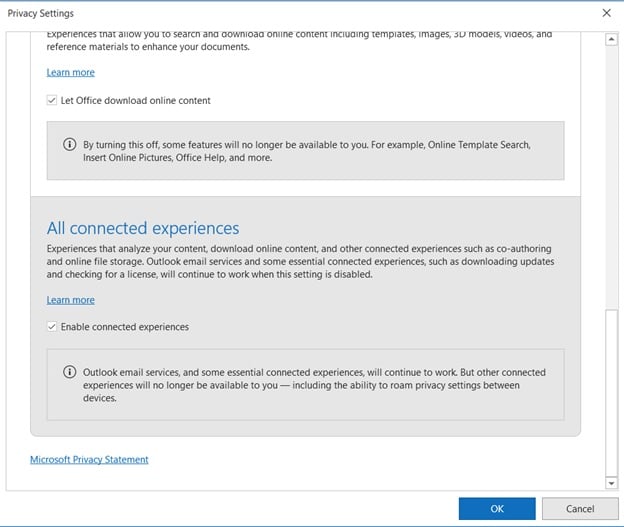Microsoft Outlook is one of the popular desktop email clients that many people use. Many of you might have come across an issue where it keeps asking for the password. Today, we will be providing a troubleshooting guide for that.
Fix Microsoft Outlook Repeatedly Keeps Asking for a Password
Solution 1: Using Credential Manager
- Close
Microsoft Outlook>> Click onStartbutton >> typeCredentialin the search box >>you will then seeCredential Manager>> Click onCredential Manager. - Under
Generic Credentialsyou’ll see an entry that has Outlook in the name. If not then check-inWindows Credentialstab, you’ll see entries withTERMSRVwhich are the entries saved by Outlook. Opening any will show username withMicrosoftAccount\emaill-addressas username, and the password is hidden.
- Delete those entries. In fact, you can delete all the entries in Generic Credentials if you like.
- Close
Credential ManagerWindow and startMicrosoft Outlook. - If it asks for a password, enter the password and check for it to remember the password.
- A new entry will be created in the credential vault with your latest login and password.
Solution 2: By enabling the ‘Remember Password’ option
If you are using a personal PC or laptop, then you must enable the ‘Remember Password’ option so that Outlook can save the password. Here’s how you should do it.
FileTab >>Account Settings>>Account Settings- Now select the account under the Email tab.
- A new window will appear. At the bottom of this window, you will see the
Remember Passwordoption.
- Make sure that this option is checked.
Solution 3: Adjusting Privacy Settings
- In Outlook, click File >> Office Account >> Account Privacy
- Click Manage Settings.
- Scroll down to the bottom where it says
Enable connected experiences. - Click the checkbox and OK.
Solution 4: For Gmail users
- Go to
Control Panel>>Mail(Microsoft Outlook 2016). - In dialogue
Mail setup, clickEmail Accountsbutton. - In dialogue
Email Accounts: inEmailtab: in the list of your email accounts, select the google account where you have problems with and click theChangethe button above the list of accounts. - In dialogue
Change Account: change the value of the textboxIncoming mail serverfromimap.gmail.comtoimap.googlemail.com. Also, change the value of the textbox Outgoing mail server (SMTP) fromsmtp.gmail.comtosmtp.googlemail.com.
Solution 5: Fix a Specific Email Account via Credential Manager
- Close your
Outlook. - Type in
Credentials Managerin the search window. - Click on
Windows Credentials. - Find the entry for your email account and click on Edit. You probably will see
Persistence: Local computer. - You need to remove the entry for that account.
- Open
Outlookand when you prompted to enter credentials – enter the password and click on Save Password. - Go back to credentials manager and confirm that settings for Persistence set to Enterprise:
Persistence: Enterprise.
Solution 6: Using Registry Editor for Older Versions
This is an old solution, but may still work. You likely have these two registry settings:
|
1 2 3 |
[HKEY_CURRENT_USER\Software\Microsoft\Office\12.0\Outlook\AutoDiscover] "domain.com"="c:\auto\autodiscover.xml" "PreferLocalXML"=dword:00000001 |
and
HKEY_CURRENT_USER\Software\Microsoft\Office\14.0\Outlook\AutoDiscover
for Outlook 2010
You must make this solution more robust by adding these registry entries to both registries:
|
1 2 3 4 5 6 |
"ExcludeScpLookup"=dword:00000001 "ExcludeHttpsAutodiscoverDomain"=dword:00000001 "ExcludeHttpsRootDomain"=dword:00000001 "ExcludeSrvLookup"=dword:00000001 "ExcludeHttpRedirect"=dword:00000000 "ExcludeSrvRecord"=dword:00000001 |
The only lookup type that will be used now is HTTP Redirect to the XML file. If this fails, there’ll be no Autodiscover.
Solution 7: By modifying the XML File
- Go to
credential managerand manually re-enter the password in all of the locations where the user’s email password is stored. - Go to
C:\Users\*user*\AppData\Local\Microsoft\Outlook\Locate the.XMLfile i.e.f0a4256167a8597a89das6hf01c6bb1b - Autodiscover.xmlor something like this. Move this file or rename it. - Relaunch Outlook, and you should not get any further prompts. The Autodiscover.xml file will be recreated automatically.
Solution 8: By enabling modern authentication
Outlook 2016 doesn’t require this, but for Outlook 13, it is recommended that you enable modern authentication. To do that, you need to modify registries. The registries, keys, and values are provided below.
HKCU\SOFTWARE\Microsoft\Office\15.0\Common\Identity\Enable ADAL | REG_DWORD | 1
HKCU\SOFTWARE\Microsoft\Office\15.0\Common\Identity\Version | REG_DWORD | 1
Once you have set the registry keys, you can set Office 2013 devices apps to use multifactor authentication (MFA) with Office 365. To enable MFA, login into admin center, select Settings > Settings and then in the Services tab, choose Modern authentication from the list.
Check the Enable modern authentication (recommended) box in the Modern authentication panel, and then choose Save changes.
Solution 9: By setting up App Password
- Go to the Security Basics page and sign in to your Microsoft account.
- Select More security options.
- Under App passwords, select Create a new app password.
- A new app password is generated and appears on your screen.
- Enter this app password where you would enter your normal Microsoft account password in the application.
- While setting up Outlook, use that password instead of your account password.
Solution 10: Using ActiveSync username (for ActiveSync users)
- You need to use your ActiveSync username, not an email address.
- Start Outlook and when it prompts you for the password, select other user and enter your ActiveSync name – starts with the server or hosting domain followed by a
\then theusername.
Example: Username: Exc091\john.doe_tempeaz.com
- Then you put your login password and check the remember password box and then hit enter on the keyboard.
Solution 11: Using Credential Manager (if you recently changed password)
- Go into
Credential Manager - Select
Windows credentials - Scroll down to the one that shows Microsoft Office 16 and click on it
- Select
edit - Enter in your
usernamethat you sign into the computer with and enter in the updated password that you just changed for your windows login - You may have to open and close Outlook a couple of times, but it will recognize your updated password and the needs password message will be gone.
Solution 12: Using CMD (for Outlook 2016)
Outlook 16 users have faced trouble with one particular version. Here’s how to fix it.
- Open a command prompt window.
- At the command prompt, run the following commands
cd %programfiles%\Common Files\Microsoft Shared\ClickToRun\
officec2rclient.exe /update user updatetoversion=12624.20466
Here the version number 12624.20466 can be different while trying the solution. Find the latest version number from this link.
Solution 13: Allow access to less secure apps (For Gmail users)
If you access Gmail through Google Chrome and use Microsoft’s Outlook 2007, then to enter Outlook without having a pop3 window from asking for the password, follow the steps below.
- Click on your Google icon, then click into security, and then scroll down to the
Less secure app accesswindow that shows the padlock. - If the Third-party access row has a black circle indicating OFF, then click on
Turn on access (not recommended), and at the next screen position the slide button toON. - Exit back, and there should now be an orange circle On with an exclamation point.
Open up Outlook. If the Inbox does not populate, then open up your email settings and make sure that your Gmail User ID and Password are entered correctly.
Solution 14: For VPN & Exchange Users
If upon upgrading from Office 2013 Pro to Office 2016, exchange account starts asking for password:
Connect via VPN to local area network where the Exchange is, go to Account Settings > Change > More Settings > Security and Uncheck Encryption: Encrypt data between Microsoft Outlook and Microsoft Exchange.
It’ll again prompt for the password once more, enter it and then turn back Encryption ON, and it’ll work fine.





RELATED ARTICLES